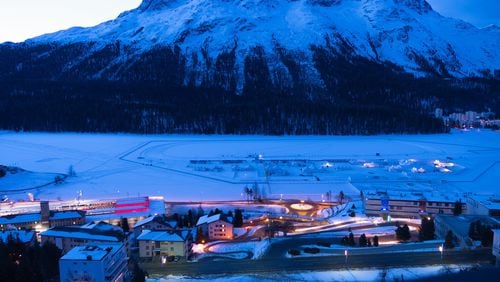By good luck, winter break was just days away at our second-grader’s public school as I flew Swiss International to represent my firm at meetings in Zurich. As business-class travelers who do the trans-Atlantic night run often enough know, you should arrive at the airport a half hour earlier than otherwise necessary, have your dinner in the lounge and sleep through the service on the plane. The Swiss lounge at JFK served me a lovely buffet meal, and I arrived in Zurich about as fresh as when I left.
Unless you are a C-level executive, business etiquette is usually to stay at a four-star hotel instead of the kind of kid-friendly (and pricier) grand hotel my family and I favor on vacations. That does not mean you are sentenced to a look-alike chain property. I chose the small Markgasse Hotel, in Zurich’s formerly down-market, now surreptitiously cool Niederdorf section, not seven minutes by foot from the Paradeplatz, the town’s main square. My room was a melody of spare and contemporary design; dinner, at the hotel’s Baltho Kueche & Bar, was a mellow arrival-night feast of oven-roasted baby chicken (a seasonal specialty).
Meetings, meetings, meetings, all with respected colleagues, then reports back to the office and, at last, two days later, my wife and son arrived. During periods of light traffic, the airport is literally 10 minutes from town by taxi, but the rail link is inexpensive, hospital-clean and rocket-fast. I took the train straight to the airport and met my family as they exited the baggage claim area. Our ski gear was already on its way to St. Moritz, using a service unique to Swiss that lets you send ahead from your departure airport whatever you bring — from Louis Vuitton luggage to snowboards — to your destination. Thereby traveling almost light just this once, off we headed east on another train, skimming the southern shore of the glistening and still Lake of Zurich, for a week of skiing in the St. Moritz region.
In Chur (an old, small city worth a visit), we changed trains to the mountain railroad. Known in English as the Rhaetian Railway, the system, with its small red cars and panoramic windows, cruises through Graubuenden, the large Alpine canton on Switzerland’s eastern border. In 2008, the section we rode became listed as a UNESCO World Heritage Site. Riding under the white-crowned Alps, the trains look like finely made red toys. Cow-studded pastures soon give way to craggy passes and waterfalls over which mountain water tumbles into ravines. You feel like you are watching a nature documentary, but it is obligingly real.
For years, my wife’s favorite Alpine base has been the Grand Hotel Kronenhoff, which is in Pontresina, a quiet town five miles outside St. Moritz. The winner of about every award and recognition available for a property in its category, the Kronenhoff, which finds its origins in a guesthouse of 1848, was comprehensively renovated in 2006-2007. My wife and I had been among the first guests at the revitalized hotel, and Ryan had later accompanied us, when he was a toddler.
The mood throughout is casual chic, which is a distinct contrast from the “I’m looking at you looking at me” quality of so many luxury resorts. The spa was designed for a serene version of apres ski. Small children get to play in an indoor mini-waterpark. As evening arrives, they share dinner together and then enjoy supervised play in the kids’ club, allowing their parents to have a romantic dinner in the main restaurant. For a treat, our son joined us one night at the woody gourmet restaurant, the Kronenstuebli, for its signature dish, pressed duck. It is the only restaurant in Switzerland that has mastered the Parisian specialty.
The original conductor of this symphony of hospitality was Heinz Hunkeler, who has since gone on to manage a sister property in St. Moritz proper, the Kulm. We split our stay, in part to see what he had done for the Kulm, which was the resort’s original grand hotel. Back in the day, verdant St. Moritz was a summer destination. The story goes that Johannes Badrutt, who founded the Kulm in 1864, bet his mostly British regular guests that, if they came back during the winter season and did not enjoy themselves as much as in summer, the visit would be on him. Badrutt won his bet-the-season wager, and St. Moritz is now one of the great winter resorts of Europe. When the snow falls, guests take to their skis. When the summer flowers bloom, they switch to hiking boots.
Hunkeler and his wife, Jenny (who runs the activities, spa and children’s programs at the hotel), have brought to the Kulm a key philosophy of the Kronenhoff, which is to make it all work without ever letting guests see how fantastically hard it is to do just that with an international staff (Swiss, Italian, Portuguese and others) serving demanding international guests. Our son speaks German, which is the primary language of the region, but English and Italian are the twin second languages of St. Moritz. During spa time, my wife and I took turns with our son and with floating in the heated, bubbly outdoor pool. We watched the afternoon sunlight play upon the rough-hewn Alpine peaks across the frozen Lake St. Moritz, casting them from brilliant white into a light hue of rose gold, then to leave them in a bath of royal blue until they disappeared into the night.
Claudia Canessa is from Peru. With her tightly cropped blond hair and festively tattooed right arm, she is not your typical gourmet chef, and her Peruvian-themed Sunny Bar, at the Kulm, is not something you typically find in a mountain resort. That is what made it so such a fun surprise as we enjoyed her signature ceviche, the el clasico, which is based on sea bass spiced with aji limo chilli.
The next evening, we headed one grand hotel over, to Da Vittorio — St. Moritz, at the Carlton. A branch of a three-star restaurant in Brusaporto, Italy, Da Vittorio is one of those places that shows the Italian determination to go head to head with the best that other national cuisines have to offer. My four-course (you can order seven) tasting menu was preceded by an octopus amuse bouche; next came tuna tartar with a celery salad atop apple mousse and then a quite unique “cappuccino” soup — in a coffee cup with mushrooms on the bottom, topped with a white truffle foam. So it went, in stages, until we had all finished the petit fours. The hotel graciously drove us back in its Bentley.
We could not leave St. Moritz without a nostalgia visit to the Suvretta House, where my wife and I once stayed and old and dear friends in Zurich visit each holiday season. In the main restaurant, jackets and ties are required even for young boys, and our son got his first experience of a dress-up dinner. As required, all men were in dark suits, and the women parading by looked as if they had extemporaneously joined in a runway show of the best cocktail dresses of the season.
We spent our final night back in Zurich, visiting our old friends; we stayed at another favorite hotel, the five-star Widder Hotel. The Widder is a combination of nine carefully preserved medieval facades. Public spaces are styled in bare stone and chrome. Ancient beams and roofing canopy contemporary, brightly lighted guest rooms, carefully integrating traditional design (and structural) elements.
This financial center that had been so workaday while I was there on business the week before was now enjoying a mild and sunny Saturday afternoon. Men and women played chess with knee-high pieces in the park on the hill — once the site of a Roman castle — atop the Lindenhof quarter of the Old Town. Families strolled through shops and couples shared beer and cocktails at outdoor tables under arcades and along the Limmat River.
Swiss Flight 16 is our regular homeward vehicle, and because it leaves at 9:50 in the morning, when flying business class, it makes sense to have a quick breakfast at your hotel (which is a treat at the Widder), and take extra time at the airport lounge for what in Bavaria is called the second breakfast — which, for me, was a made-to-order egg-white omelet, accompanied not by orange juice but a glass of Papillion Chasseles de Romandie, a white wine from the canton of Vaud. Onboard, I asked a flight attendant to mix mimosas, which was further proof that the business portion of the trip was far behind us. The next morning, however, work and school would begin once more and parents and son would have many good stories to tell about their winter break in the Swiss Alps.
Getting there: Swiss International Air Lines flies nonstop to Zurich from eight North American cities. www.swiss.com
If you want to see how trains should run, ride with Swiss Rail. If you plan on extensive use of the railway system, consider purchasing rail passes at favorable rates before departure: http://www.myswitzerland.com/en-us/swiss-travel-pass.html; or Rail Europe: www.raileurope.com; from USA: 1-800-622-8600; from Canada: 1-800-112-6680.
Staying there: Grand Hotel Kronenhof, Via Maistra130, 7504 Pontresina; www.kronenhof.com; +41-81-830-30-30.
Kulm Hotel St. Moritz, Via Veglia 18, 7500 St. Moritz; www.kulm.com
Marktgasse Hotel, Marktgasse 17, 8001 Zurich; www.marktgassehotel.ch; +41-44-266-10-10.
Widder Hotel, Rennweg 7, 8001 Zurich; www.widderhotel.com; +41-44-224-25-26.
The Kulm and the Widder are members of The Leading Hotels of the World; from the USA and Canada: www.lhw.com; 1-800-745-8883.
Dining there: The restaurants at the hotels above, and: Da Vittorio, Carlton Hotel St. Moritz, info@carlton-stmoritz.ch (attention concierge).
Grand Restaurant, Suvretta House (St. Moritz), reservations@suvrettahouse.ch (attention concierge).
Gifts for the staff: Confiserie Spruengli, on the Paradaplatz in Zurich. You can’t miss it; any tram you are likely to take will bring you there.
About the Author






